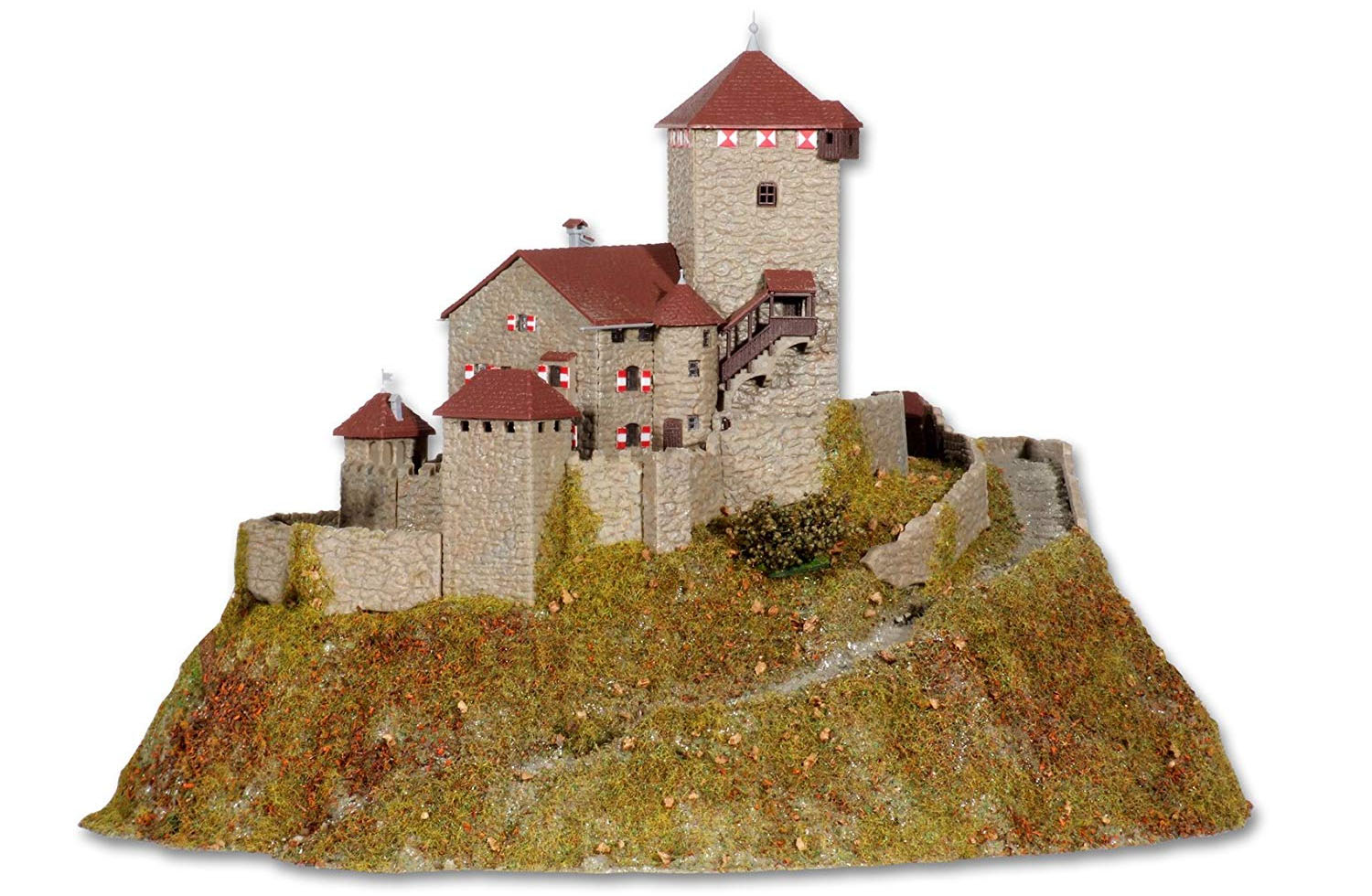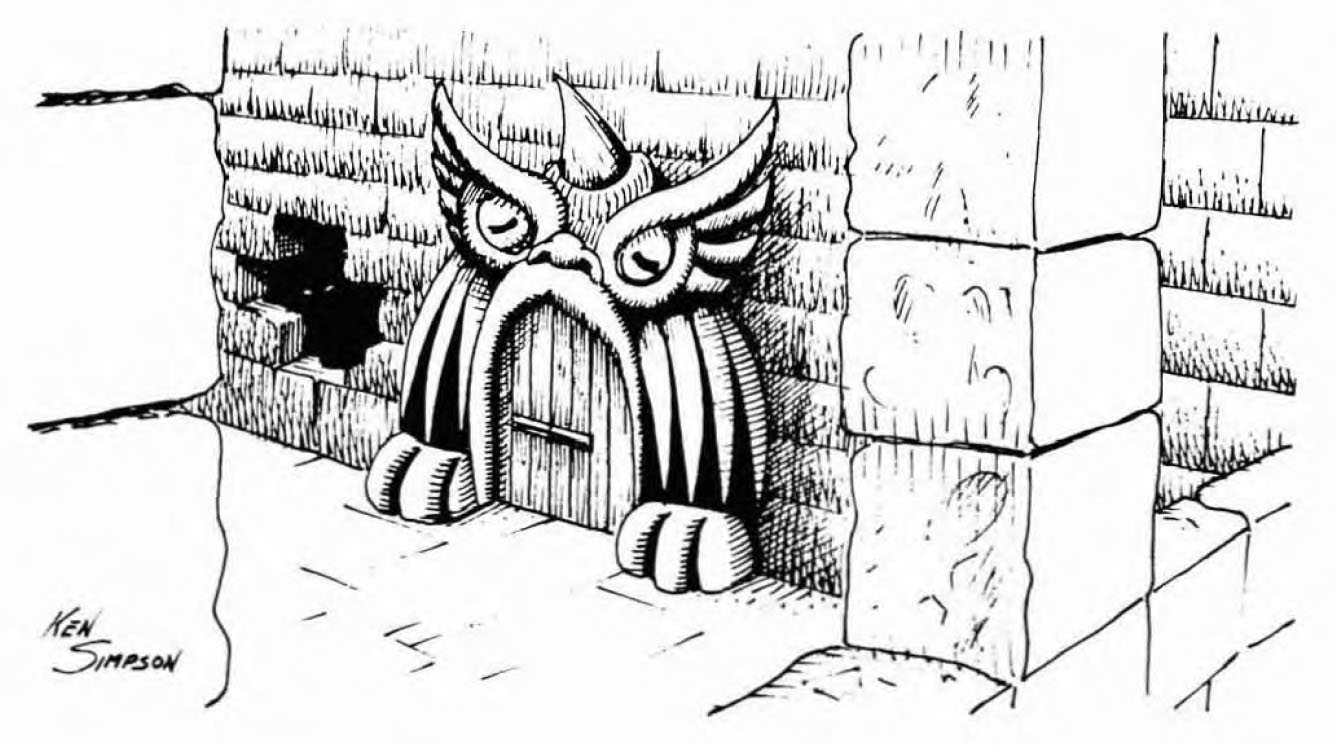The story goes that Dave Arneson’s Napoleonics players showed up for the game one week and discovered that Arneson had set up the model of a medieval castle on his ping-pong table. That evening they went on the first dungeoncrawl in history and the modern roleplaying game was born!
A great deal of confusion existed for a number of decades because Arneson had misremembered what model he had used. Thanks to Jeff Berry, we now know that the model Arneson had was Kibri model No. 37304, an N-Gauge model of Branzoll Castle. (A model which, not coincidentally, precisely matches the maps of Castle Blackmoor in the First Fantasy Campaign.) So not only do we know exactly what Castle Blackmoor looked like, it turns out that Kibri still manufactures this model kit! You can buy your own copy of Castle Blackmoor for $70-80!
CASTLE BLACKMOOR
- The castle was built during the reign of Robert I, but a fortress has stood at this location throughout recorded history and the castle incorporates many of the underground galleries of the older structures. Moat was created 400 years ago by the wizard Pissaic during the great Ben-Hassock invasions.
- The Coot Invasion began when the former Baron Wesley – now known as the Weasel – betrayed the Great Kingdom, lured the other local noblemen into Castle Blackmoor’s library, and slaughtered them. (“All that is really known is that they entered but never left and no trace of them was ever found.”) The Weasel now serves as loyal lieutenant to the Egg of Coot.
- The current ruler of Blackmoor, Baron Fant, rose to that position by virtue of his actions during the Coot Invasion.
- GM Note: See p. 21-23 of the First Fantasy Campaign for additional background material and maps.
EGG OF COOT
- This all consuming personality lives off the egos of others to support his own ego.
- At one time of humanoid appearance (or so historical records say), but his current appearance is uncertain – a huge mass of jointly operating cells, an undulating jelly, a thickly hided egg, pure energy, a lotus-eating man, a mass of living rock, etc.
- Communications with the Egg are through either direct mental transmission or an Old World artifact in his throne room which allows him to transmit from his City-Palace.
- His realm lies northeast of the castle, beyond the Wolf’s Head Pass (see First Fantasy Campaign, p. 18). [I imagine his City-Palace as a sort of cargo cult edifice of the Old World, with its peoples subjugated into a hive mind consciousness on the edge of the Egg’s vast, domineering mentality.]
FIRST SCENARIO
- Soukup, a treacherous agent of the Egg of Coot, placed Baron Fant into a magical sleep and flees into the dungeons below the castle.
- PCs are sent in pursuit.
- GM Note: Baron Fant has actually been infected with vampirism. (Historically, he becomes the infamous Sir Fang.)
DESIGN NOTES
The scenario here is meant to be evocative of, but not a precise duplicate, of the First Dungeon Adventure as described by Greg Svenson. (The enemy agent Soukup is a transparent homage to Jim Soukup, who played the balrog in the original scenario.)
It should be noted that it has become fairly apparent that the scenario described by Svenson is not, in fact, “the first dungeon adventure in history of Dungeons & Dragons.” (Although it is very possible that he’s unintentionally conflating details from different sessions.) I strongly suspect that the scenario hook that Svenson describes — the Bad Guys have done something to Baron Fant and fled into the dungeons — is, in fact, the event in which Fant was transformed into Sir Fang (the first vampire in the history of Dungeons & Dragons), which is why that’s reflected in my selected scenario hook here.
(In the real world, Dave Fant — Baron Fant’s player — had taken a job and needed to withdraw from playing in the campaign, as described in this interview. Arneson apparently came up with the idea of turning him into a vampire.)
DUNGEON FEATURES – ON THE MAP
Stairs: All stairs are circular (though not drawn that way). 20 to 30 feet between levels.
Secret Doors (Thin Wall): Anywhere there is a “thin wall” between areas.
Devil Fountains (Black Dots): Made of black, glass-like material with ruby eyes, gold horns, silver accoutrements. They spew out sulfuric acid. They are highly magical. Attempts to molest them will cause a great howling of sound and earth tremors, followed by the entire area collapsing into ruin.
Fire Pits (Crosshatch): Deep flue-like chimneys that go into the deepest parts of the dungeon to connect with the great lava pit beneath the castle (level 25). There is always a low railing (2 to 3 feet) around them. Often marked with religious images, etc.
Note: The famed Orcian Way does not yet exist. It’s also likely that the tunnels on Level 1 were not yet collapsed.
DUNGEON FEATURES – OTHER FEATURES
Catacombs: Honeycombing the hill that Blackmoor Castle has always stood upon are a series of tunnels and galleries which have been used for a number of purposes throughout history.
The Tombs: Area used for the final resting places of Blackmoor nobility and distinguished warriors. Haunted.
The Gallery of the Undead: Used during the Plague of the Undead as their headquarters and temple to perform their unholy rites.
Dungeons & Torture Chamber: Used by various sadistic Dukes or Barons of the past. Torture chamber is lost; it was sealed up at some point in the past.
Wizard’s Pit: Former ruler of Blackmoor’s Attendant Wizard practiced his arts here. Workshop was destroyed some 500 years ago due to the nature of his research. Wizard was imprisoned here when it was sealed up.
The Black Pit: An area of noxious fumes and bottomless pools caused by some natural phenomena where it is, of course, rumored that a gate to Hades is located.
Sealed Treasure Vaults: Sections filled with treasure and then sealed up (to hide it from those besieging the castle; or, more recently, by delvers hoping to return for it).
DESIGN NOTES
Although it was not my goal to attempt to “recreate” Arneson’s original dungeon key, I did want to tap into his creative palette. So I sucked the material here out of the First Fantasy Campaign to both understand his conception of the sorts of sub-complexes the dungeon would contain (catacombs, tombs, wizard laboratories, etc.). For my own utility, I’m also planning to print out a copy of 101 Curious Items to supplement my description of the dungeon.













